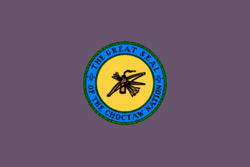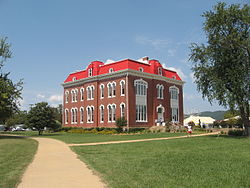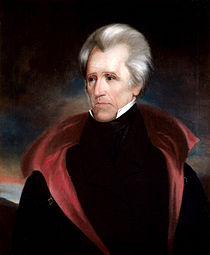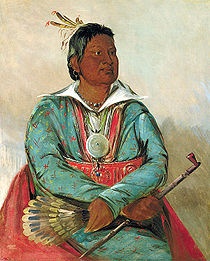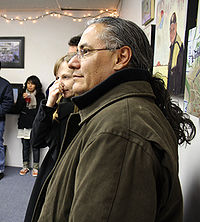- Choctaw Nation of Oklahoma
-
"Choctaw Nation" redirects here. For other uses, see Choctaw Nation (disambiguation).
Choctaw Nation of Oklahoma Total population 215,947[1] Regions with significant populations  United States (
United States ( Oklahoma)
Oklahoma)Languages English, Choctaw
Religion Protestantism, traditional beliefs
Related ethnic groups The Choctaw Nation of Oklahoma (commonly referred to as the Choctaw Nation) is a semi-autonomous Native American homeland comprising twelve tribal districts. The Choctaw Nation maintains a special relationship with both the United States and Oklahoma governments. Approximately 250,000 people live within the Choctaw Nation, of which 70,000 are enrolled Choctaw.
The chief of the Choctaw Nation is Gregory Eli Pyle. The Choctaw Nation Headquarters is located in Durant, Oklahoma, though the Choctaw Capitol Building is in Tuskahoma, Oklahoma; it is now the Choctaw Museum and home to the Judicial Department Court System.
Another federally recognized tribe is the Mississippi Band of Choctaw Indians. These are descendants of Choctaw who chose to stay in Mississippi rather than relocate to Indian Territory. At the time, they were to accept US citizenship and federal and state laws. The Choctaw preserved much of their culture in small communities and reorganized as a tribal government under new laws after the Indian Reorganization Act of 1934.
Those Choctaw who removed to the Indian Territory, a process that went on into the early 20th century, are federally recognized as the Choctaw Nation of Oklahoma.[2] The removals became known as the "Trail of Tears."
Contents
Geography
The Choctaw Nation of Oklahoma covers approximately 11,000 square miles (28,000 km2) of land, encompassing eight whole counties and most of/portions of five counties in Southeastern Oklahoma; Atoka County, most of Bryan County, Choctaw County, most of Coal County, Haskell County, half of Hughes County, a portion of Johnston County, Latimer County, Le Flore County, McCurtain County, Pittsburg County, a portion of Pontotoc County, and Pushmataha County.
Government
The Tribal Headquarters are located in Durant, Oklahoma, consisting of a complex of three 3-story buildings, and several one-story buildings. The current chief is Gregory E. Pyle and the assistant chief is Gary Batton. The current number of Choctaw memberships is approximately 188,000.
The Tribe is governed by the Choctaw Nation Constitution, which was ratified by the people on June 9, 1984. The Constitution provides for an Executive, a Legislative and a Judicial branch of government. The Chief of the Choctaw Tribe, elected every four years, is not a voting member of the Tribal Council. They are also elected for four years. The legislative authority of the Tribe is vested in the Tribal Council, which consists of 12 members.
Tribal Council
Members of the Tribal Council are elected by the Choctaw people. Twelve Council members are elected, one for each of the twelve districts in the Choctaw Nation.
Tribal Council Members
- District 1 - Hap Ward
- District 2 - Tony Messenger
- District 3 - Kenny Bryant
- District 4 - Delton Cox
- District 5 - Ron Perry
- District 6 - Joe Coley
- District 7 - Jack Austin
- District 8 - Perry Thompson
- District 9 - Ted Dosh
- District 10 - Anthony Dillard
- District 11 - Bob Pate
- District 12 - James Frazier
In order to be elected as a Council member, candidates must have resided in their respective districts for at least one year immediately preceding the election. Once elected, a Council member must remain a resident of the district from which he or she was elected during the term in office. This policy ensures the involvement and interaction of successful candidates with their constituency.
Once in office, the Tribal Council Members have regularly scheduled county council meetings. The presence of these tribal leaders in the Indian community creates a sense of understanding of their community and its needs. The Tribal Council is responsible for adopting rules and regulations which govern the Choctaw Nation, for approving all budgets, making decisions concerning the management of tribal property, and all other legislative matters. The Tribal Council Members are the voice and representation of the Choctaw people in the tribal government.
The Tribal Council's assists the community in its ability to implement an economic development strategy and to plan, organize, and direct Tribal resources in a comprehensive manner to achieve self-sufficiency. The Tribal Council is working to strengthen the Nation's economy, with efforts being focused on the creation of additional job opportunities through promotion and development. By planning and implementing its own programs and building a strong economic base, the Choctaw Nation applies its own fiscal, natural, and human resources to develop self-sufficiency.
Chiefs
Before Oklahoma was admitted to the union in 1907, the Choctaw Nation was divided into three districts: Apukshunnubbee, Moshulatubbee, and Pushmataha. Each district had its own chief from 1834 to 1857; afterward, the three districts were put under the jurisdiction of one chief. After statehood, these districts were abolished.
Apukshunnubbee District
During Removal
- Greenwood LeFlore: 1830–1834
Indian Territory
- Thomas LeFlore: 1834–1838; 1842–1850
- James Fletcher: 1838–1842
- George W. Harkins: 1850–1857
Moshulatubbee District
During Removal
- Mushulatubbee Amosholi: 1830–1834
Indian Territory
- Moshulatubbe Amosholi: 1834–1836
- Joseph Kincaid: 1836–1838
- John McKinney: 1838–1842
- Nathaniel Folsom (Choctaw chief): 1842–1846
- Peter Folsom (Choctaw chief): 1846–1850
- Cornelius McCurtain: 1850–1854
- David McCoy: 1854–1857
Pushmataha District
During Removal
- Nitakechi: 1830–1834
Indian Territory
- Nitakechi: 1834–1838
- Pierre Juzan: 1841–1846
- Isaac Folsom: 1841–1846
- Silas Fisher: 1846–1850
- George Folsom: 1850–1854
- David McCoy: 1854–1857
After 1857
- Alfred Wade: 1857–1858
- Tandy Walker: 1858–1859
- Basil LeFlore: 1859–1860
- George Hudson: 1860–1862
- Samuel Garland: 1862–1864
- Peter Pitchlynn: 1864–1866
- Allen Wright: 1866–1870
- William Bryant: 1870–1874
- Coleman Cole: 1874–1878
- Isaac Levi Garvin: 1878–1880
- Jackson F. McCurtain: 1880–1884
- Edmund McCurtain: 1884–1886
- Thompson McKinney: 1886–1888
- Ben Smallwood: 1888–1890
- Wilson N. Jones: 1890–1894
- Jefferson Gardner: 1894–1896
- Green McCurtain: 1896–1900; 1902–1910
- Gilbert Wesley Dukes: 1900–1902
- Victor Locke, Jr.: 1910–1918
- William F. Semple: 1918–1922
- William H. Harrison: 1922–1929
- Ben Dwight: 1929–1937
- William Durant: 1937–1948
- Harry J. W. Belvin: 1948–1975
- Clark David Gardner: 1975–1978
- Hollis E. Roberts: 1978–1997
- Gregory E. Pyle: 1997–Present
Economy
The Choctaw Nation's annual tribal economic impact is over $822,000,000.[3] The Choctaw Nation employs about 8,000 people worldwide, 2,000 of those work in Bryan County, Oklahoma; the Choctaw Nation is also Durant's largest single employer. The nation's payroll is about $180 million per year, with total revenues from tribal businesses and governmental entities topping $1 billion.
The nation has contributed to raising Bryan County's per capita income to about $24,000. The Choctaw Nation has helped build water systems and towers, roads and other infrastructure, and has contributed to additional fire stations, EMS units and law enforcement needs that come with economic growth.
The Choctaw Nation operates several types of businesses, in Bryan County and elsewhere: casinos, travel plazas; Blue Ribbon Downs racetrack, a horse racing enterprise that provides satellite-signal access to races across the U.S.; a printing operation, a corporate drug testing service, hospice care, a metal fabrication and manufacturing business, a document backup and archiving business, and a management services company that provides staffing at military bases, embassies and other sites, among other enterprises.
Health System
The Choctaw Nation is the first indigenous tribe in the world to build their own hospital with their own funding. The Choctaw Nation Health Care Center, located in Talihina, is a 145,000-square-foot (13,500 m2) health facility with 37 hospital beds for inpatient care and 52 exam rooms. The $22 million hospital is complete with $6 million worth of state-of-the-art equipment and furnishing. It serves 150,000 - 210,000 outpatient visits annually. The hospital also houses the Choctaw Nation Health Services Authority, the hub of the health care services covering the ten and a half-county area of Southeastern Oklahoma.
The tribe also operates eight Indian clinics, one each in Atoka, Broken Bow, Durant, Hugo, Idabel, McAlester, Poteau, and Stigler.
2008 Freedom Award
In July 2008, the United States Department of Defense announced the 2008 Secretary of Defense Employer Support Freedom Award recipients. They are awarded the highest recognition given by the U.S. Government to employers for their outstanding support of employees who serve in the National Guard and Reserve.
The Choctaw Nation was one of 15 recipients of this year's Freedom Award, selected from 2,199 nominations. Their representatives received the award September 18, 2008 in Washington, D.C. The Choctaw Nation is the first Native American tribe to receive this award.
History
Treaty of Dancing Rabbit Creek (1830)
At Andrew Jackson's request, the United States Congress opened a fierce debate on an Indian Removal Bill.[4] In the end, the bill passed, but the vote was very close. The Senate passed the measure 28 to 19, while in the House it narrowly passed, 102 to 97. Jackson signed the legislation into law June 30, 1830,[4] and turned his focus onto the Choctaw in Mississippi Territory.
On August 25, 1830, the Choctaws were supposed to meet with Andrew Jackson in Franklin, Tennessee, but Greenwood Leflore, a district Choctaw chief, informed Secretary of War John H. Eaton that the warriors were fiercely opposed to attending.[5] President Jackson was angered. Journalist Len Green writes "although angered by the Choctaw refusal to meet him in Tennessee, Jackson felt from LeFlore's words that he might have a foot in the door and dispatched Secretary of War Eaton and John Coffee to meet with the Choctaws in their nation."[6] Jackson appointed Eaton and General John Coffee as commissioners to represent him to meet the Choctaws at the Dancing Rabbit Creek near present-day Noxubee County, Mississippi.[citation needed]
“ Say to them as friends and brothers to listen [to] the voice of their father, & friend. Where [they] now are, they and my white children are too near each other to live in harmony & peace ... It is their white brothers and my wishes for them to remove beyond the Mississippi, it [contains] the [best] advice to both the Choctaws and Chickasaws, whose happiness ... will certainly be promoted by removing ... There ... their children can live upon [it as] long as grass grows or water runs ... It shall be theirs forever ... and all who wish to remain as citizens [shall have] reservations laid out to cover [their improv]ements; and the justice due [from a] father to his red children will [be awarded to] them. [Again I] beg you, tell them to listen. [The plan proposed] is the only one by which [they can be] perpetuated as a nation ... I am very respectfully your friend, & the friend of my Choctaw and Chickasaw brethren. Andrew Jackson. -Andrew Jackson to the Choctaw & Chickasaw Nations, 1829.[7] ” The commissioners met with the chiefs and headmen on September 15, 1830, at Dancing Rabbit Creek.[8] In carnival-like atmosphere, the policy of removal was explained to an audience of 6,000 men, women, and children.[8] The Choctaws would now face migration or submit to U.S. law as citizens.[8] The treaty would sign away the remaining traditional homeland to the United States; however, a provision in the treaty made removal more acceptable.[citation needed]
“ ART. XIV. Each Choctaw head of a family being desirous to remain and become a citizen of the States, shall be permitted to do so, by signifying his intention to the Agent within six months from the ratification of this Treaty, and he or she shall thereupon be entitled to a reservation of one section of six hundred and forty acres of land ... -Treaty of Dancing Rabbit Creek, 1830 ” On September 27, 1830, the Treaty of Dancing Rabbit Creek was signed. It represented one of the largest transfers of land that was signed between the U.S. Government and Native Americans without being instigated by warfare. By the treaty, the Choctaws signed away their remaining traditional homelands, opening them up for European-American settlement. Article 14 allowed for nearly 1,300 Choctaws to remain in the state of Mississippi and to become the first major non-European ethnic group to become U.S. citizens.[9][10][11][12] Article 22 sought to put a Choctaw representative in the U.S. House of Representatives.[9] The Choctaw at this crucial time split into two distinct groups: the Choctaw Nation of Oklahoma and the Mississippi Band of Choctaw Indians. The nation retained its autonomy, but the tribe in Mississippi submitted to state and federal laws.[13]
“ To the voters of Mississippi. Fellow Citizens:-I have fought for you, I have been by your own act, made a citizen of your state; ... According to your laws I am an American citizen, ... I have always battled on the side of this republic ... I have been told by my white brethren, that the pen of history is impartial, and that in after years, our forlorn kindred will have justice and "mercy too" ... I wish you would elect me a member to the next Congress of the [United] States.-Mushulatubba, Christian Mirror and N.H. Observer, July 1830.[14] ” Great Irish Famine aid (1847)
Midway through the Great Irish Famine (1845–1849), a group of Choctaws collected $710 (although many articles say the original amount was $170 after a misprint in Angie Debo's The Rise and Fall of the Choctaw Republic) and sent it to help starving Irish men, women and children. "It had been just 16 years since the Choctaw people had experienced the Trail of Tears, and they had faced starvation… It was an amazing gesture. By today's standards, it might be a million dollars," according to Judy Allen, editor of the Choctaw Nation of Oklahoma's newspaper, Bishinik. The paper is based at the Oklahoma Choctaw tribal headquarters in Durant, Okla. To mark the 150th anniversary, eight Irish people retraced the Trail of Tears.[15]
Ferguson states, "1903 MISS: Three-hundred Mississippi Choctaws were persuaded to remove to the Nation [in Oklahoma]."[2]
Territory Transition to Statehood (1900)
By the early twentieth century, the Choctaw had lost much of their sovereignty and tribal rights in preparation for the Indian Territory becoming the state of Oklahoma in 1907. The Dawes Commission registered tribal members in official rolls, and gave out individual land allotments.
Pioneering the Use of Code Talking (1918)
During World War I the American army fighting in France became stymied by the Germans' ability to intercept its communications. Even worse, after intercepting them the Germans were also able to decrypt the codes, reading the Americans' secrets and knowing in advance their every move.
Several Choctaw Indians serving in the 142nd Infantry came upon an idea: using their native tongue, the Choctaw language, to transmit army secrets. Their gambit proved very successful, and almost immediately contributed to a turn-around on the Muse-Argonne front. Captured German officers said they were baffled by the Choctaw words, which they were completely unable to translate. Historians credit these soldiers with helping bring World War I to a faster conclusion.
There were fourteen Choctaw Code Talkers. Their success was emulated during World War II, this time by soldiers from a number of American Indian tribes. Collectively these Indians are known as code talkers.
Self-determination (1970s)
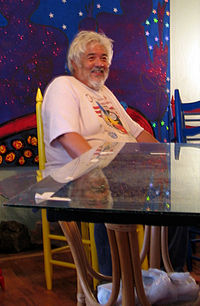 Ron Anderson, Choctaw-Chickasaw installation artist, painter, and sculptor from Oklahoma
Ron Anderson, Choctaw-Chickasaw installation artist, painter, and sculptor from Oklahoma
The 1970s were a crucial and defining decade for the Choctaw. To a large degree, the Choctaw repudiated the more extreme Indian activism. They sought a local grassroots solution to reclaim their cultural identity and sovereignty as a nation.
On August 24, just hours before it would become law, Richard Nixon signed a bill repealing the Termination Act of 1959.[clarification needed] This close call prompted some Oklahoma Choctaw to spearhead a grassroots movement to change the direction of the tribal government. In 1971, the Choctaw held their first popular election of a chief since Oklahoma entered the Union in 1907.
A group calling themselves the Oklahoma City Council of Choctaws, endorsed thirty-one year old David Gardner for chief, in opposition to the current chief, seventy-year-old Harry Belvin. Gardner campaigned on a platform of greater financial accountability, increased educational benefits, the creation of a tribal newspaper, and increased economic opportunities for the Choctaw people. Amid charges of fraud and rule changes concerning age, Gardner was declared ineligible to run as he did not meet the new minimum age requirement of thirty-five. Belvin was re-elected to a four-year term as chief.
In 1975, thirty-five-year-old David Gardner defeated Belvin to become the Choctaw Nation's second popularly elected chief. 1975 also marked the year that the United States Congress passed the landmark Indian Self-Determination and Education Assistance Act. This law revolutionized the relationship between Indian Nations and the federal government.
Native American tribes such as the Choctaw were granted the power to negotiate and contract directly for services, as well as to determine what services were in the best interest of their people. Under Gardner's term as chief, a tribal newspaper, Hello Choctaw, was established. Along with the Creek and Cherokee, the Choctaw successfully sued the federal and state government over riverbed rights to the Arkansas River.
Discussions began on the issue of drafting and adopting a new constitution for the Choctaw people. A movement began to officially enroll more Choctaws, increase voter participation, and preserve the Choctaw language. In early 1978, David Gardner died of cancer at the age of thirty-seven. Hollis Roberts was elected chief in a special election, serving from 1978-1997.
A new publication, the Bishinik, replaced Hello Choctaw in June 1978. Spirited debates over a proposed constitution divided the people. In May 1979, they adopted a new constitution for the Choctaw nation.
Faced with termination as a sovereign nation in 1970, the Choctaws emerged a decade later as a tribal government with a constitution, a popularly elected chief, a newspaper, and the prospects of an emerging economy and infrastructure that would serve as the basis for further empowerment and growth. Due to their changes and achievements made during the 1970s, the Choctaw today are a progressive and successful people, facing the twenty-first century with renewed hope and optimism.
Notable tribal members
- Marcus Amerman (b. 1959), bead, glass, and performance artist
- Michael Burrage (b. 1950), former U.S. District Judge
- Steve Burrage (b. 1952), Oklahoma State Auditor and Inspector
- Choctaw Code Talkers, World War I veterans
- Clarence Carnes (1927–1988), Alcatraz inmate
- Tobias William Frazier, Sr. (1892–1975), code talker
- Kalyn Free, attorney
- Rosella Hightower (1920–2008), prima ballerina
- Phil Lucas (1942–2007), filmmaker
- Green McCurtain (d. 1910), Chief from 1902–1910
- Cal McLish (1925–2010), Major League Baseball pitcher
- Devon A. Mihesuah (b. 1957), author, editor, historian
- Peter Pitchlynn (1806–1881), Chief from 1860–1866
- Gregory E. Pyle (b. 1949), current Chief of the Choctaw Nation
- Seneca Scott (b. 1977), current State Representative
- Wallis Willis, composer and Choctaw freedman
Citations
- ^ "Pocket Pictorial." Oklahoma Indian Affairs Commission. 2010: 9. . Retrieved 10 June 2010.
- ^ a b Ferguson, Bob; Leigh Marshall (1997). "Chronology". Mississippi Band of Choctaw Indians. Archived from the original on 2007-10-10. http://web.archive.org/web/20071010062645/http://www.choctaw.org/history/chronology.htm. Retrieved 2008-02-05.
- ^ http://www.ok.gov/oiac/documents/FY2010.POCKET.PIC.pdf
- ^ a b Sharyn Kane & Richard Keeton. "Fort Benning - The Land and the People". SEAC. http://www.nps.gov/history/seac/benning-book/ch11.htm. Retrieved 2010-08-07.
- ^ Remini, Robert (1977, 1998). ""Brothers, Listen ... You Must Submit"". Andrew Jackson. History Book Club. p. 272. ISBN 0965063107.
- ^ Green, Len (October 1978). "Choctaw Treaties". Bishinik. Archived from the original on 2007-12-15. http://web.archive.org/web/20071215033006/http://www.tc.umn.edu/~mboucher/mikebouchweb/choctaw/chotreat.htm. Retrieved 2008-03-21.
- ^ Len Green (2009). "President Andrew Jackson’s Original Instructions to the “Civilized” Indian Tribes to Move West". The Raab Collection. http://www.raabcollection.com/manuscript/Andrew-Jackson-Autograph-Trail.aspx. Retrieved 2009-09-28.
- ^ a b c Remini, Robert (1977, 1998). ""Brothers, Listen ... You Must Submit"". Andrew Jackson. History Book Club. ISBN 0965063107.
- ^ a b Kappler, Charles (1904). "INDIAN AFFAIRS: LAWS AND TREATIES Vol. II, Treaties". Government Printing Office. http://digital.library.okstate.edu/kappler/Vol2/treaties/cho0310.htm. Retrieved 2008-04-16.
- ^ Baird, David (1973). "The Choctaws Meet the Americans, 1783 to 1843". The Choctaw People. United States: Indian Tribal Series. p. 36. Library of Congress 73-80708.
- ^ Council of Indian Nations (2005). "History & Culture, Citizenship Act - 1924". Council of Indian Nations. http://www.nrcprograms.org/site/PageServer?pagename=cin_hist_citizenshipact. Retrieved 2008-05-02.
- ^ Carleton, Ken (2002). "A Brief History of the Mississippi Band of Choctaw Indians" (PDF). Mississippi Archaeological Association. http://www.msarchaeology.org/maa/carleton.pdf. Retrieved 2009-05-04.
- ^ Kidwell (2007); Kidwell (1995)
- ^ "An Indian Candidate for Congress". Christian Mirror and N.H. Observer, Shirley, Hyde & Co.. July 15, 1830.
- ^ Ward, Mike (1992). "Irish Repay Choctaw Famine Gift: March Traces Trail of Tears in Trek for Somalian Relief". American-Stateman Capitol. http://www.uwm.edu/~michael/choctaw/retrace.html. Retrieved 2007-09-20.
See also
External links
- Choctaw Nation of Oklahoma, official website
- Choctaw Nation Health Services Authority
- Okla Chahta Clan of California, Inc., heritage group
Choctaw Federally recognized tribes Culture History Politics and law Native American tribes in Oklahoma Federally
recognized
tribesAbsentee-Shawnee Tribe of Indians of Oklahoma · Alabama-Quassarte Tribal Town · Apache Tribe of Oklahoma · Caddo Nation of Oklahoma · Cherokee Nation · Cheyenne and Arapaho Tribes · Chickasaw Nation · Choctaw Nation of Oklahoma · Citizen Potawatomi Nation · Comanche Nation · Delaware Nation · Delaware Tribe of Indians · Eastern Shawnee Tribe of Oklahoma · Fort Sill Apache Tribe of Oklahoma · Iowa Tribe of Oklahoma · Kaw Nation · Kialegee Tribal Town · Kickapoo Tribe of Oklahoma · Kiowa Indian Tribe of Oklahoma · Miami Tribe of Oklahoma · Modoc Tribe of Oklahoma · Muscogee Creek Nation · Osage Tribe · Otoe-Missouria Tribe of Indians · Ottawa Tribe of Oklahoma · Pawnee Nation of Oklahoma · Peoria Tribe of Indians of Oklahoma · Ponca Tribe of Indians of Oklahoma · Quapaw Tribe of Indians · Sac and Fox Nation · Seminole Nation of Oklahoma · Seneca-Cayuga Tribe of Oklahoma · Shawnee Tribe · Thlopthlocco Tribal Town · Tonkawa Tribe of Indians of Oklahoma · United Keetoowah Band of Cherokee Indians in Oklahoma · Wichita and Affiliated Tribes · Wyandotte NationTribal languages
(still spoken)Alabama · Arapaho · Caddo · Cayuga · Cherokee · Cheyenne · Chickasaw · Chiwere (Iowa and Otoe) · Choctaw · Comanche · Delaware · Koasati · Hitchiti-Mikasuki · Mescalero-Chiricahua · Mesquakie (Fox, Kickapoo, and Sauk) · Muscogee · Osage · Ottawa · Pawnee · Ponca · Potawatomi · Quapaw · Seneca · Shawnee · Wichita · Wyandot · YuchiFive Civilized Tribes Categories:- Choctaw
- Native American tribes in Oklahoma
- Federally recognized tribes in the United States
Wikimedia Foundation. 2010.

